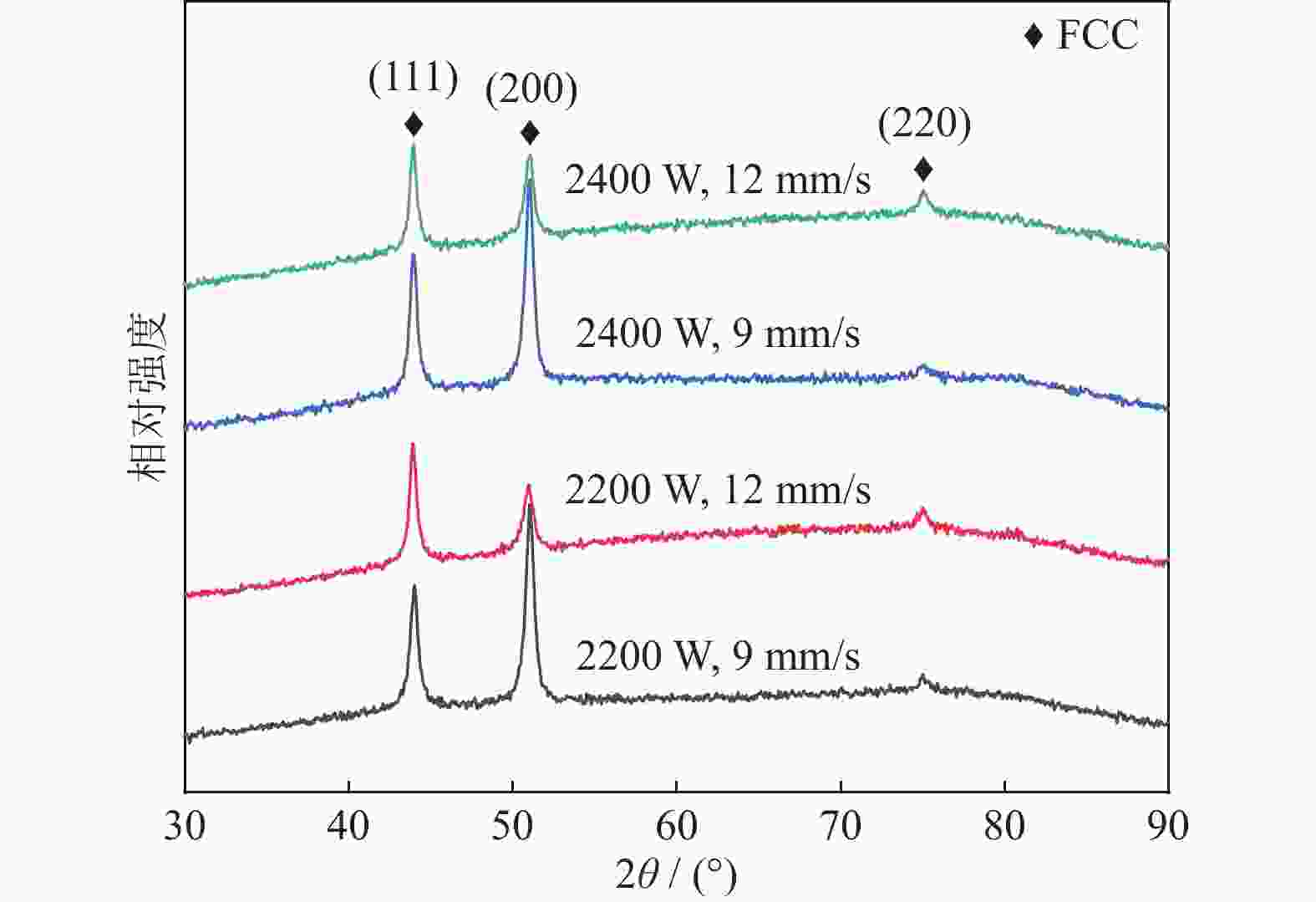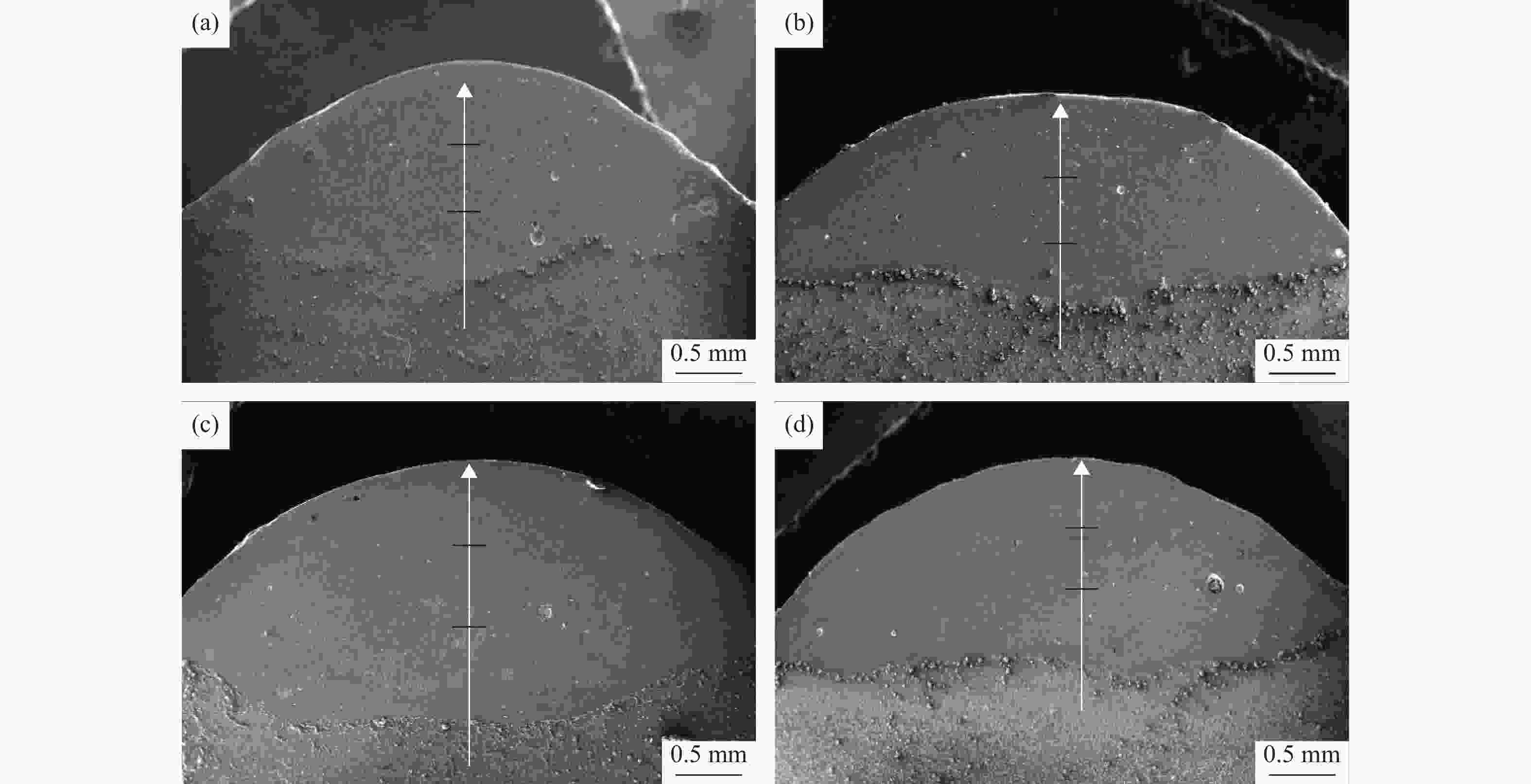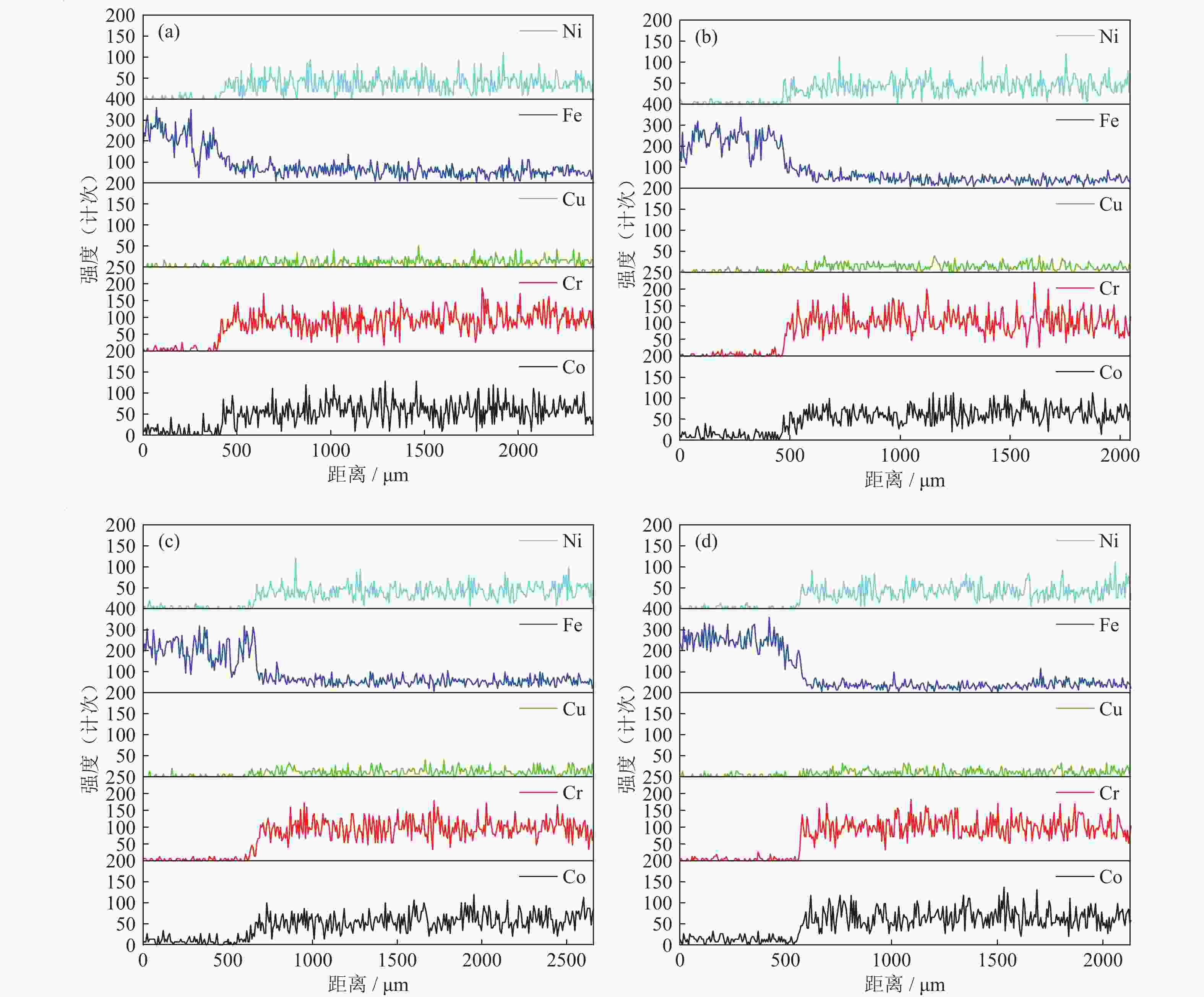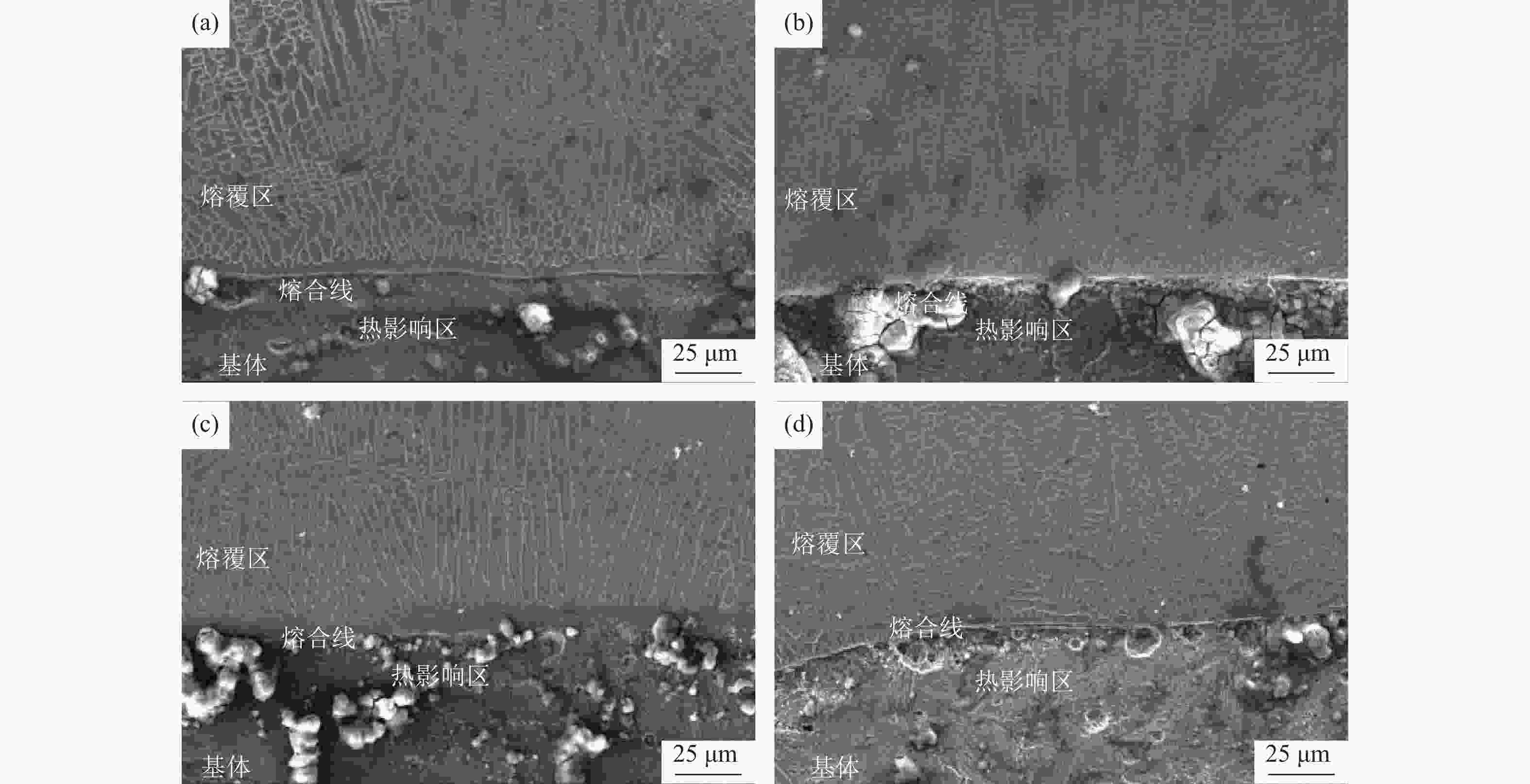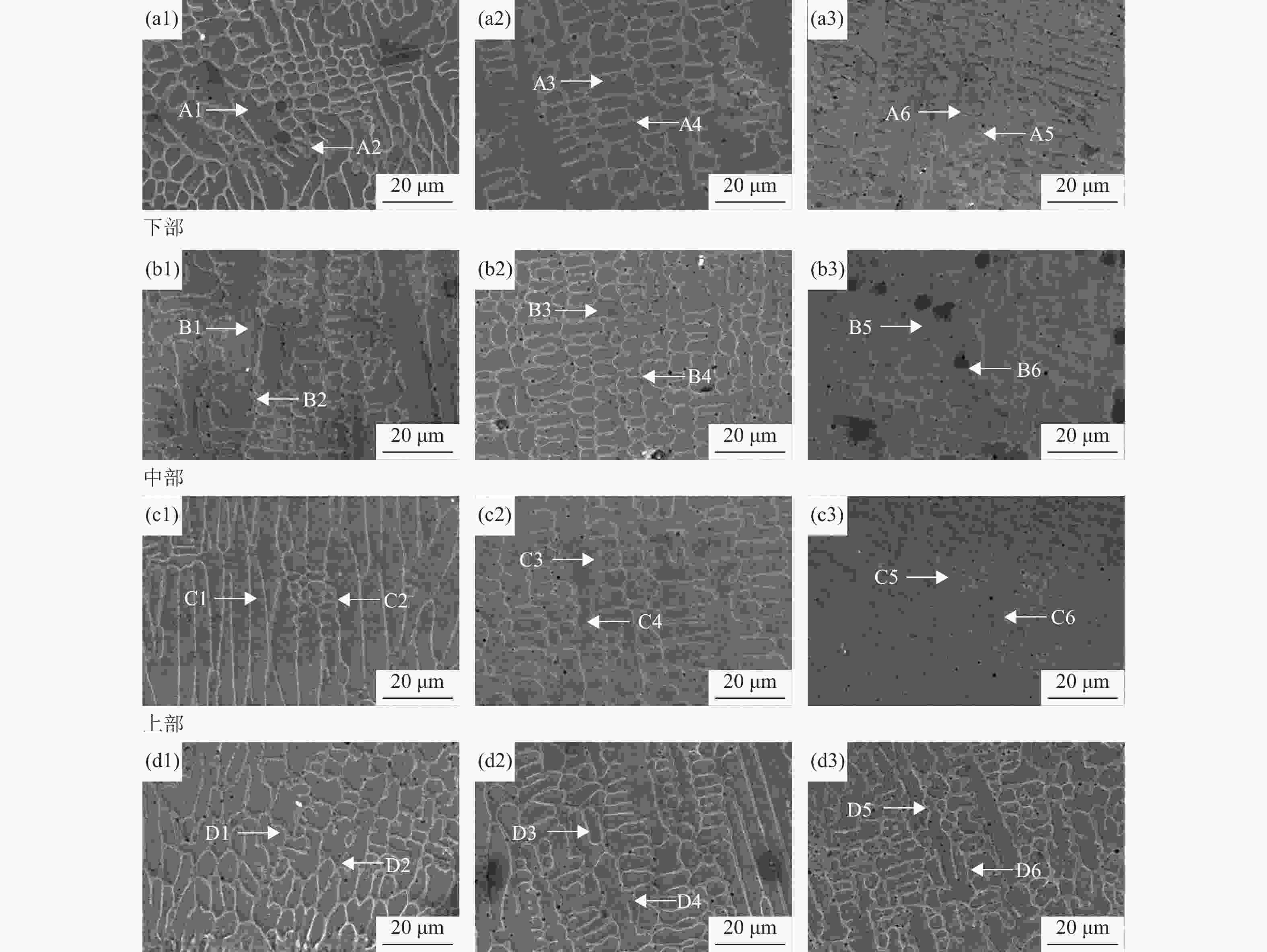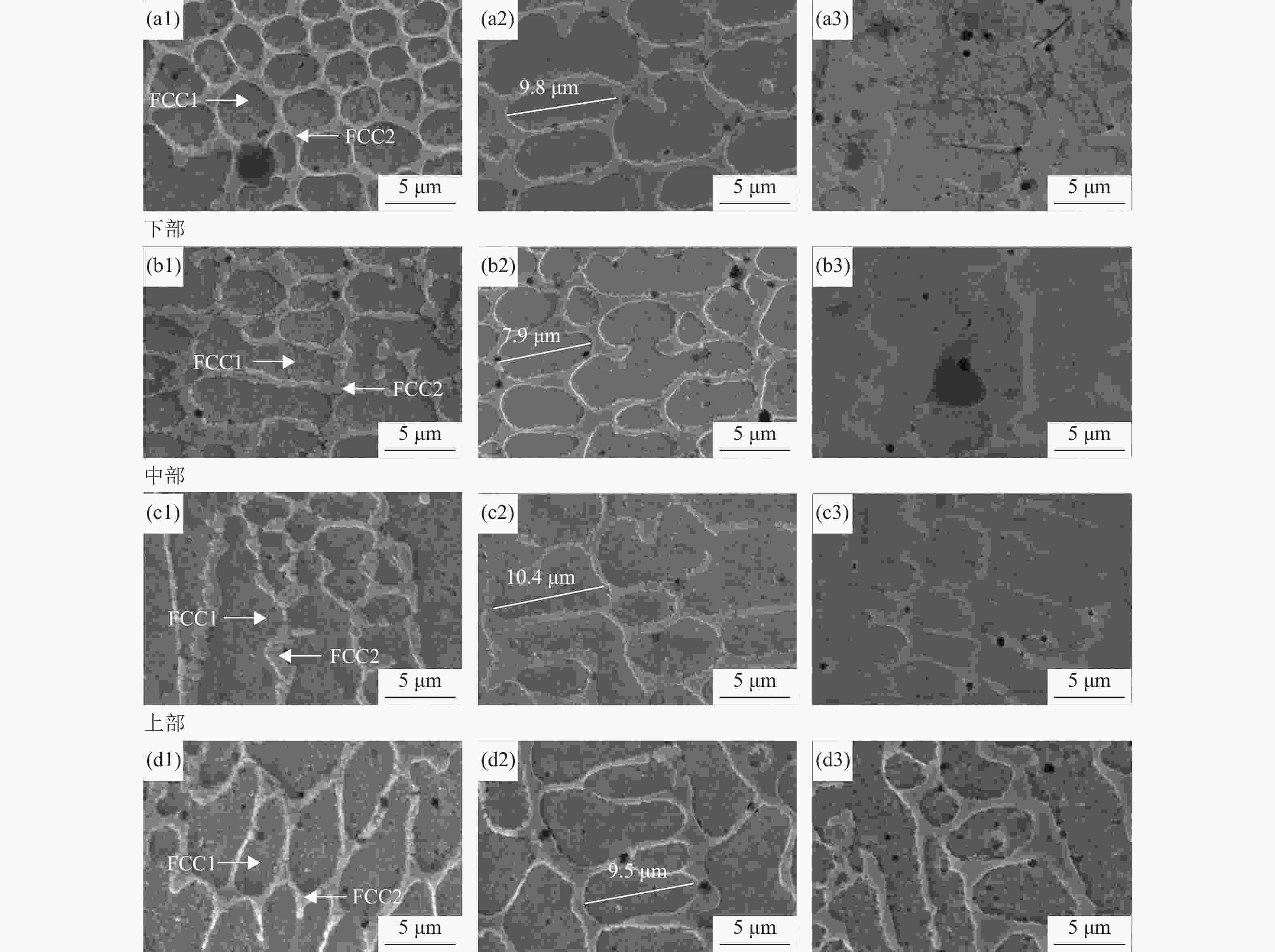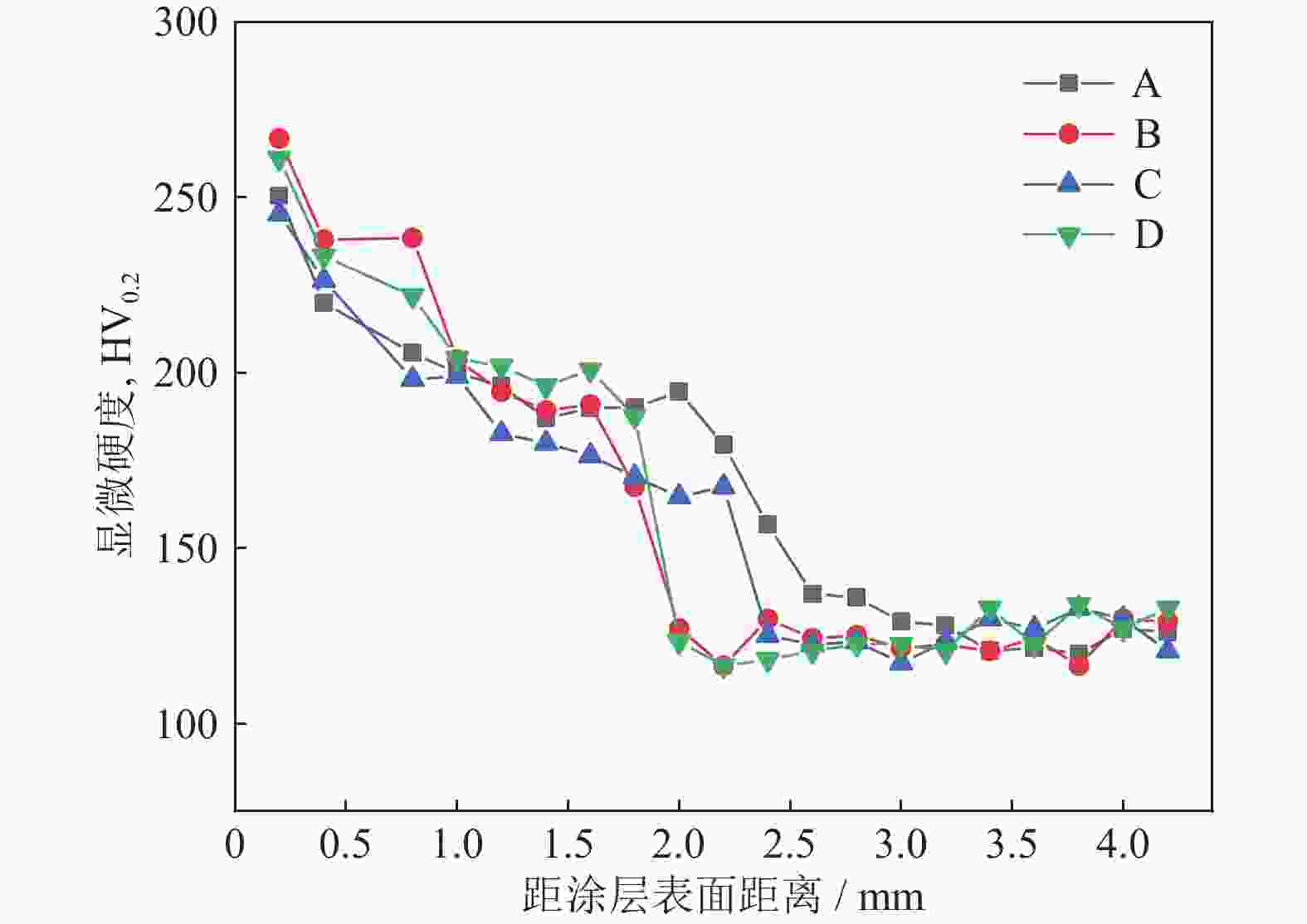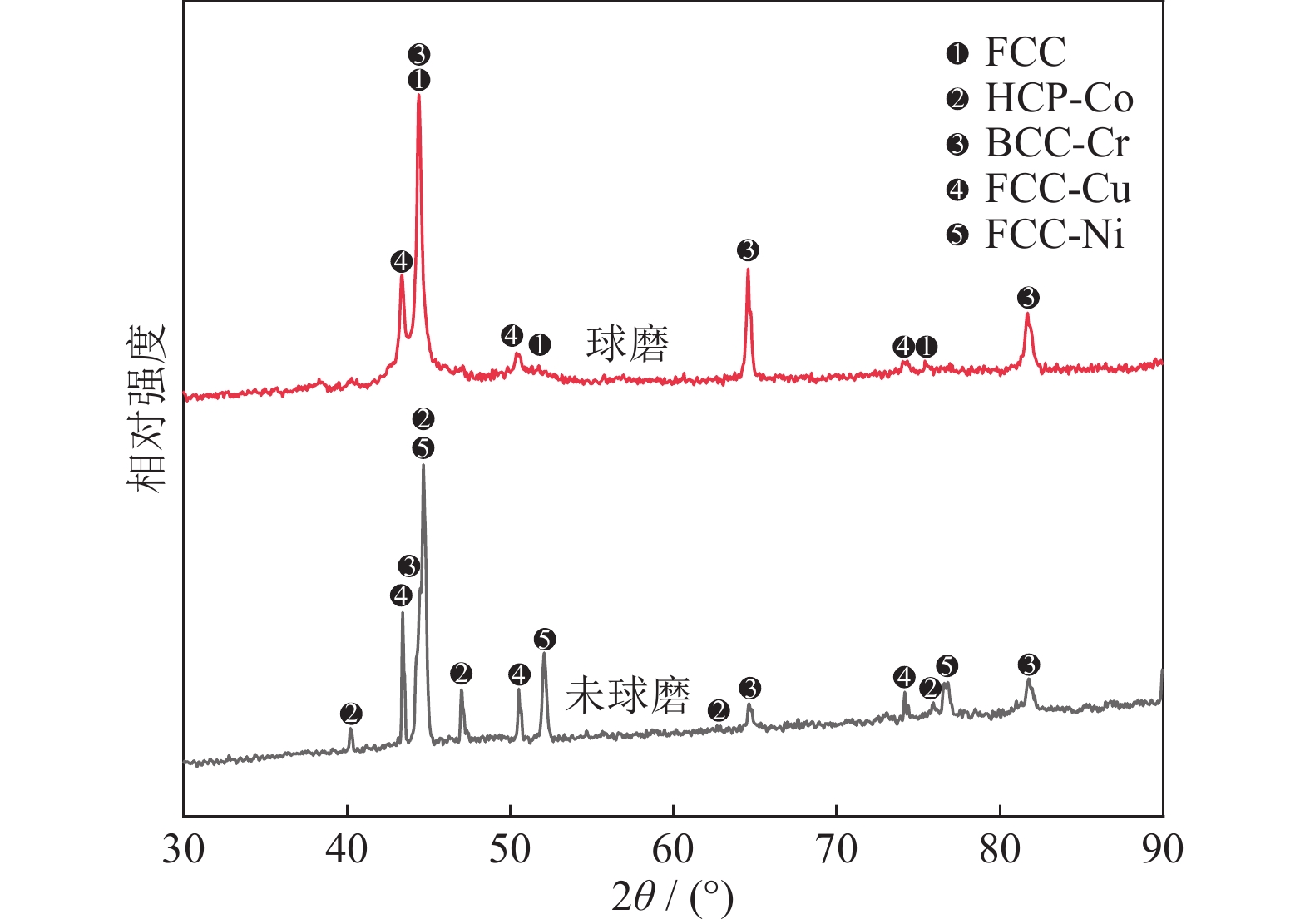Microstructure and phase stability analysis of laser cladding CoCrCu0.4FeNi high entropy alloy coatings
-
摘要: 为提高零部件的硬度和耐磨性,采用Co、Cr、Cu和Ni单质金属粉末在Q235钢基体上激光熔覆CoCrCu0.4FeNi高熵合金涂层,利用扫描电镜、能谱仪和X射线衍射仪分析了涂层的微观组织,测试了涂层的显微硬度,并利用第一性原理计算了涂层中各相的晶格常数和弹性常数。结果表明,涂层与基体形成了良好的冶金结合,且无宏观裂纹和气孔等缺陷;涂层微观组织主要由树枝晶和枝晶间组成,其中树枝晶为一种面心立方相(FCC1),富Cu贫Cr,枝晶间为另一种面心立方相(FCC2),富Cr贫Cu。涂层厚度约为1.50~1.98 mm,涂层枝晶大小约为7.9~10.4 μm。涂层的显微硬度约为HV0.2 170~230,约为基体1.7倍,随着与涂层表面距离的增加,涂层的硬度逐渐降低。另外,激光功率越低,扫描速度越大,树枝晶越细小,细晶强化的作用越强,涂层的硬度越高。涂层中面心立方(FCC)相的晶格常数计算值与实验值误差为1.33%~2.60%,FCC相的生成热均为负值,且弹性常数C11、C12和C44满足立方结构高熵合金的力学稳定性限制条件,可知FCC相是稳定的。由剪切模量与体积模量之比(G/B)<0.57、泊松比(ν)>0.26可知,树枝晶和枝晶间处的FCC相总体呈现韧性特征。从涂层下部到上部,计算的弹性模量逐渐增加,硬度增大,与实验硬度变化规律相符合。Abstract: To improve the hardness and wear resistance of parts, the Co, Cr, Cu, and Ni elemental metal powders were used to prepare the CoCrCu0.4FeNi high entropy alloy coatings on Q235 steel substrate by laser cladding. The microstructure of the high entropy alloy coatings was analyzed by scanning electron microscope (SEM), energy dispersive spectroscopy (EDS), and X-ray diffraction (XRD), and the microhardness of the coatings was measured. The lattice and elastic constants of each phase in the coatings were calculated by the first principle. The results show that, the coatings show the good metallurgical bond with the substrate without the macro-cracks and pores. The microstructure of the coatings is mainly composed of dendrite and interdendrite. The dendrite is one kind of face-centered cubic phase (FCC1), rich Cu and poor Cr, the interdendrite is another kind of face-centered cubic phase (FCC2), rich Cr and poor Cu. The thickness of the coatings is about 1.50~1.98 mm, and the size of the coating dendrite is about 7.9~10.4 μm. The microhardness of the coatings is about HV0.2 170~230, about 1.7 times that of the substrate, and the hardness of the coatings gradually decreases with the increase of the distance from the coating surface. In addition, the lower the laser power, the higher the scanning speed, the finer the dendrite, the stronger the effect of fine grain strengthening, and the higher the hardness of the coating. The error between the calculated lattice constant and the experimental value of face-centered cubic (FCC) phases in the coatings is 1.33%~2.60%. The formation heat of FCC phases is negative, and the elastic constants C11, C12, and C44 meet the mechanical stability constraints of the cubic high entropy alloy, showing the FCC phases are stable. The FCC phases at the dendrite and interdendrite are generally present as the characteristics of toughness according to the ratio of shear modulus to bulk modulus (G/B)<0.57 and Poisson's ratio (ν)>0.26. From the lower part to the upper part of the coatings, the calculated elastic modulus and hardness increase gradually, which is consistent with the variation law of the experimental data.
-
Key words:
- laser cladding /
- high-entropy alloys /
- microhardness /
- coatings /
- first-principles
-
表 1 Q235钢基体化学成分(质量分数)
Table 1. Chemical composition of the Q235 steel substrate
% C Si Mn S P Fe 0.160 0.080 0.021 0.012 0.015 余量 表 2 涂层下部、中部和上部能谱分析(原子分数)
Table 2. EDS analysis of the CoCrCu0.4FeNi coatings in the lower, middle, and upper part
% 元素 Co Cr Cu Fe Ni A1 19.1 17.7 5.4 41.0 16.8 A2 16.9 27.1 4.8 38.0 13.2 A3 28.4 21.6 7.2 20.6 22.2 A4 24.3 36.9 5.9 16.8 16.1 A5 27.3 23.8 7.3 19.4 22.2 A6 24.4 30.0 7.1 19.1 19.4 B1 24.3 23.7 7.7 22.0 22.2 B2 22.8 34.3 4.6 19.4 18.9 B3 28.2 24.9 7.6 16.0 23.3 B4 26.7 37.6 3.8 15.0 16.9 B5 29.3 21.5 8.0 16.5 24.8 B6 26.2 32.7 4.8 16.3 20.0 C1 17.3 15.2 4.2 50.8 12.5 C2 19.4 25.9 3.4 36.6 14.8 C3 26.7 21.0 8.2 21.9 22.3 C4 25.4 30.2 6.0 19.5 18.9 C5 27.6 22.6 7.8 18.8 23.2 C6 27.9 35.2 4.8 14.4 17.7 D1 25.8 19.8 7.8 28.5 18.0 D2 23.6 34.5 5.3 22.7 13.9 D3 26.8 22.8 7.3 20.5 22.6 D4 25.5 30.9 6.2 16.7 20.7 D5 29.3 24.0 8.5 16.3 21.9 D6 27.4 35.8 4.5 14.6 17.7 表 3 FCC和BCC结构优化后的单原子基态能量
Table 3. Monatomic ground state energy after the FCC and BCC structure optimization
eV 位置 FCC BCC D1 −3249.29 −3249.01 D2 −3106.14 −3105.87 D3 −3287.32 −3287.06 D4 −3201.61 −3201.34 D5 −3247.98 −3247.73 D6 −3172.63 −3172.42 表 4 D1~D6处相的晶格常数
Table 4. Lattice constants of the phases at D1~D6
位置 晶格常数计算值 / Å 计算值与实验值误差 / % D1 3.492 1.47~2.54 D2 3.497 1.33~2.40 D3 3.490 1.52~2.60 D4 3.492 1.47~2.54 D5 3.494 1.43~2.48 D6 3.490 1.52~2.60 注:误差=|实验平均值−计算值|/实验平均值 表 5 D1~D6处相的基态总能量和生成热
Table 5. Total ground state energy and formation heat of the phases at D1~D6
位置 基态总能量,Etotal / eV 生成热,Eform / eV D1 −12997.16 −9263.95 D2 −12424.56 −9215.07 D3 −13149.28 −9740.94 D4 −12806.44 −9486.65 D5 −12991.92 −9612.07 D6 −12690.52 −9411.57 表 6 D1~D6处相的弹性常数
Table 6. Elastic constants of the phases at D1~D6
位置 C11 / GPa C12 / GPa C44 / GPa C11−C12 / GPa C12+2C12 / GPa D1 332.92 180.68 189.50 152.24 694.28 D2 353.45 190.64 187.36 162.81 734.73 D3 339.79 179.85 197.75 159.94 699.49 D4 341.07 189.36 200.93 151.71 719.79 D5 328.61 178.22 184.21 150.39 685.05 D6 357.18 193.07 207.43 164.11 743.32 表 7 D1~D6处相的体积模量、剪切模量、杨氏模量、泊松比和G/B
Table 7. Bulk modulus, shear modulus, Young’s modulus, Poisson’s ratio, and G/B of the phases at D1~D6
位置 体积模量,B / GPa 剪切模量,G / GPa 杨氏模量,E / GPa 泊松比,ν G/B BV BR BH GV GR GH EV ER EH νV νR νH D1 231.42 231.42 231.42 144.15 118.75 131.45 358.10 304.22 331.57 0.242 0.281 0.261 0.568 D2 244.91 244.91 244.91 144.98 123.21 134.10 363.26 316.56 340.20 0.253 0.285 0.268 0.548 D3 233.16 233.16 233.16 150.64 124.44 137.54 371.83 316.94 344.82 0.234 0.273 0.254 0.589 D4 239.93 239.93 239.93 150.90 121.08 135.99 374.24 310.93 343.14 0.240 0.284 0.262 0.557 D5 228.35 228.35 228.35 140.61 116.60 128.60 349.99 298.92 324.83 0.245 0.282 0.263 0.563 D6 247.77 247.77 247.77 157.28 128.74 143.01 389.44 329.21 359.81 0.238 0.279 0.258 0.577 -
[1] Yeh J W, Chen S K, Lin S J, et al. Nanostructured high-entropy alloys with multiple principal elements: novel alloy design concepts and outcomes. Adv Eng Mater, 2004, 6(5): 299 doi: 10.1002/adem.200300567 [2] Chang H, Zhao S, Liu C H. Preparation and properties of (AlCrMoNbZr)1− x − y N y O x high entropy alloy coating. J Funct, 2019, 50(4): 4174常鸿, 赵莎, 刘春海. (AlCrMoNbZr)1− x − y N y O x 高熵合金涂层的制备及性能研究. 功能材料, 2019, 50(4): 4174 [3] Xin W, Wang Y J, Wei S C, et al. Research progress of the preparation of high entropy alloy coatings by spraying. Chin J Eng, 2021, 43(2): 170辛蔚, 王玉江, 魏世丞, 等. 热喷涂制备高熵合金涂层的研究现状与展望. 工程科学学报, 2021, 43(2): 170 [4] Tian H L, Zhang X M, Jin G, et al. Research status and prospect of high entropy alloy coating prepared by electrospark deposition. Mater Rep, 2021, 35(Suppl 1): 342田浩亮, 张晓敏, 金国, 等. 电火花沉积高熵合金涂层的研究现状与展望. 材料导报, 2021, 35(增刊1): 342 [5] Fu Y, Huang C, Du C W, et al. Evolution in microstructure, wear, corrosion, and tribocorrosion behavior of Mo-containing high-entropy alloy coatings fabricated by laser cladding. Corros Sci, 2021, 191: 109727 doi: 10.1016/j.corsci.2021.109727 [6] Hao W J, Sun R L, Niu W, et al. Study on microstructure and corrosion resistance of CoCrFeNiSi x high-entropy alloy coating by laser cladding. Surf Technol, 2021, 50(8): 343郝文俊, 孙荣禄, 牛伟, 等. 激光熔覆CoCrFeNiS x 高熵合金涂层组织及耐蚀性能研究. 表面技术, 2021, 50(8): 343 [7] Li Y Z, Shi Y. Microhardness, wear resistance, and corrosion resistance of Al x CrFeCoNiCu high-entropy alloy coatings on aluminum by laser cladding. Opt Laser Technol, 2021, 134(6): 106632 [8] Wen L Z, Huang Y S. Microstructure and property of laser cladding CoCrCu1/2FeMoNiTi high-entropy alloys coating. Powder Metall Technol, 2016, 34(4): 268温立哲, 黄元盛. 激光熔覆AlCoCrCu1/2FeMoNiTi高熵合金涂层的组织与性能. 粉末冶金技术, 2016, 34(4): 268 [9] Chen S Y, Xu S H, Wang L, et al. Study on laser cladding FeAlCrNiSiC high entropy alloy coating. Appl Laser, 2015(1): 7 doi: 10.14128/j.cnki.al.20153501.007陈岁元, 徐世海, 王力, 等. 激光熔覆FeAlCrNiSiC高熵合金涂层研究. 应用激光, 2015(1): 7 doi: 10.14128/j.cnki.al.20153501.007 [10] Wang Z, Shang X J, Tian X Q, et al. Effects of laser cladding process parameters on microstructure and properties of MoFeCrTiWAlNb high-melting-point and high-entropy alloy coating. Mater Prot, 2021, 54(4): 94 doi: 10.16577/j.cnki.42-1215/tb.2021.04.018汪震, 尚晓娟, 田兴强, 等. 激光熔覆工艺参数对MoFeCrTiWAlNb高熔点高熵合金涂层组织和性能的影响. 材料保护, 2021, 54(4): 94 doi: 10.16577/j.cnki.42-1215/tb.2021.04.018 [11] Zhang Y, Han T F, Xiao M, et al. Effect of process parameters on the microstructure and properties of laser-clad FeNiCoCrTi0.5 high-entropy alloy coating. Int J Miner Metall Mater, 2020, 27(5): 630 doi: 10.1007/s12613-019-1958-7 [12] Tian F Y, Wang D P, Shen J, et al. An ab initio investigation of ideal tensile and shear strength of TiVNbMo high-entropy alloy. Mater Lett, 2016, 166: 271 doi: 10.1016/j.matlet.2015.12.064 [13] Wu H, Huang S R, Zhu C Y, et al. Influence of Cr content on the microstructure and mechanical properties of Cr x FeNiCu high entropy alloys. Prog Nat Sci, 2020, 30: 239 doi: 10.1016/j.pnsc.2020.01.012 [14] Liao M Q, Liu Y, Min L J, et al. Alloying effect on phase stability, elastic and thermodynamic properties of Nb−Ti−V−Zr high entropy alloy. Intermetallics, 2018, 101: 152 doi: 10.1016/j.intermet.2018.08.003 [15] Xu H Y, Meng W L, Lu J B, et al. Phase and stability analysis of CrCuFeNiTi high entropy alloy coating based on first principles. Heat Treat Met, 2021, 7(46): 60 doi: 10.13251/j.issn.0254-6051.2021.07.012徐洪洋, 孟雯露, 卢金斌, 等. 基于第一性原理的CrCuFeNiTi高熵合金涂层的相及稳定性分析. 金属热处理, 2021, 7(46): 60 doi: 10.13251/j.issn.0254-6051.2021.07.012 [16] Zhang L J, Fan J T, Liu D J, et al. The microstructural evolution and hardness of the equiatomic CoCrCuFeNi high-entropy alloy in the semi-solid state. J Alloys Compd, 2018, 745: 75 doi: 10.1016/j.jallcom.2018.02.170 [17] Verma A, Tarata P, Abhyankar A C, et al. High temperature wear in CoCrFeNiCu x high entropy alloys: The role of Cu. Scr Mater, 2019, 161: 28 doi: 10.1016/j.scriptamat.2018.10.007 [18] Segall M D, Philip J D, Probert M J, et al. First-principles simulation: ideas, illustrations and the CASTEP code. J Phys Condens Matter, 2002, 14(11): 2717 doi: 10.1088/0953-8984/14/11/301 [19] Larkin J M, Mcgaughey A J H. Predicting alloy vibrational mode properties using lattice dynamics calculations, molecular dynamics simulations, and the virtual crystal approximation. J Appl Phys, 2013, 114(2): 023507 doi: 10.1063/1.4812737 [20] Perdew J P, Burke K, Ernzerhof M. Generalized gradient approximation made simple. Phys Rev Lett, 1996, 77: 3865 doi: 10.1103/PhysRevLett.77.3865 [21] Hamann D R, Schluter M, Chiang C, et al. Norm-conserving pseudopotentials. Phys Rev Lett, 1979, 43(20): 1494 doi: 10.1103/PhysRevLett.43.1494 [22] Yin B J. Influence of technological parameters on laser cladding of NiWC25 alloy powder. Hot work technol, 2021, 50(4): 106 doi: 10.14158/j.cnki.1001-3814.20183960尹保健. 工艺参数对激光熔覆NiWC25合金粉末的影响. 热加工工艺, 2021, 50(4): 106 doi: 10.14158/j.cnki.1001-3814.20183960 [23] Xu P, Zhu L, Xue P, et al. Multi-track alternated overlapping model suitable for variable laser cladding process parameters. Surf Coat Technol, 2021, 425: 127706 doi: 10.1016/j.surfcoat.2021.127706 [24] Zhang W W, Wang C J, Sun B, et al. Insight into the phase transition, elastic and thermodynamic properties of BeS compound under high pressure and temperature from the first principle calculation. Vacuum, 2021, 186: 110017 doi: 10.1016/j.vacuum.2020.110017 [25] Papadimitriou I, Utton C, Scott A, et al. Ab initio study of the intermetallics in Nb−Si binary system. Intermetallics, 2020, 54: 125 -



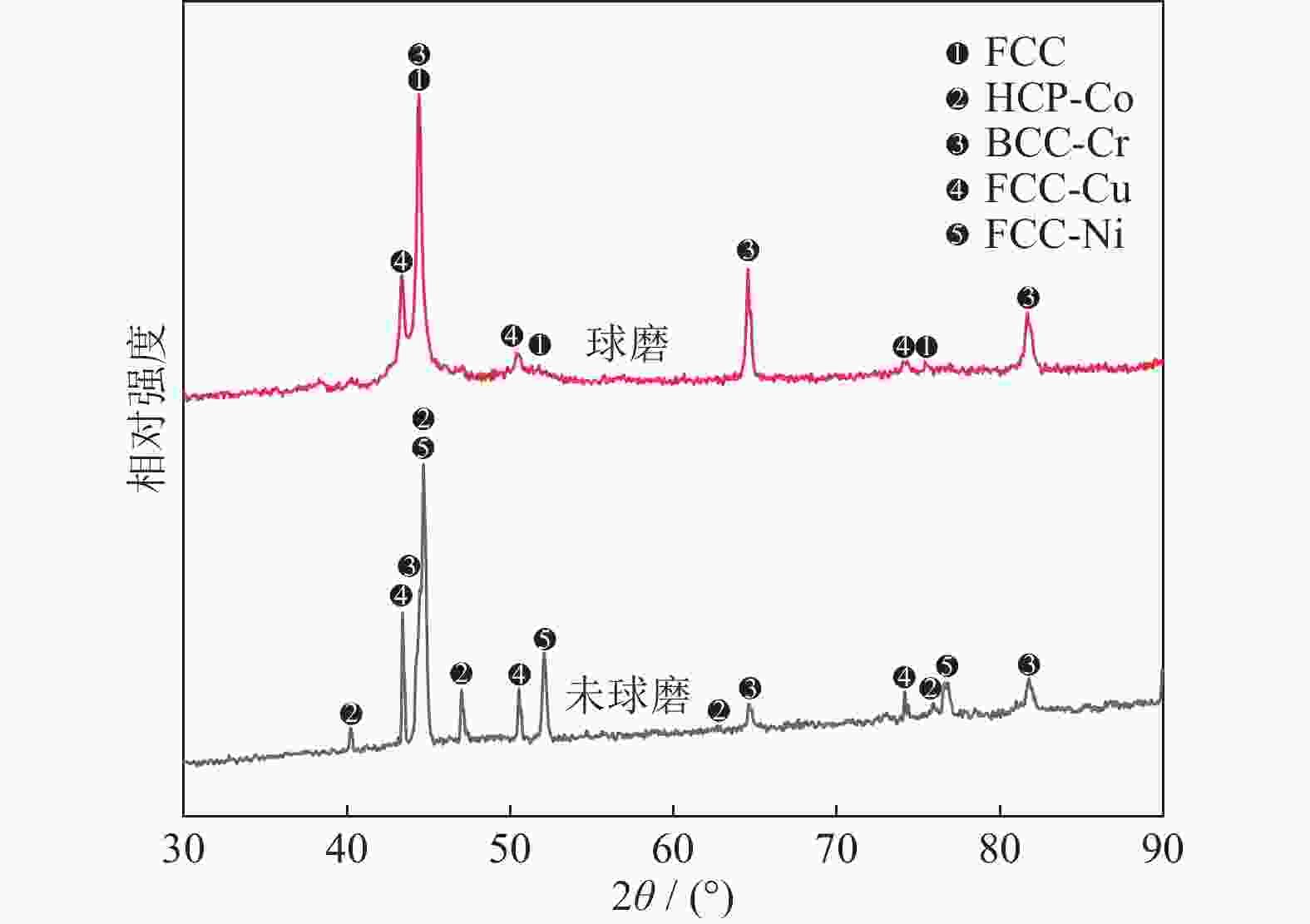
 下载:
下载:
